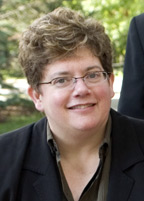Leader, facilitator and overseer: Provost's role has expanded over seven decades
By Linda Grace-Kobas

Biddy Martin's presentation of the first Provost's Annual Academic State of the University address March 7 will mark another milestone in the evolving role of the Cornell provost.
When President David Skorton announced the address Feb. 8, he spoke of his hope that the speech will "engage the entire community in a regular and sustained public dialogue."
Martin, the first woman to serve as provost since the position was created in 1931, succeeds 13 men, most of them scientists, seven of whom went on to become presidents of Cornell or other universities.
The provost's duties have changed fundamentally since 1943 when a trustee discussion "held that one of the great virtues of the title of provost is its ambiguity." Today, Martin serves as the president's first deputy officer and the university's chief educational officer and chief operating officer. She oversees all academic programs except those that report to the provost for medical affairs at Weill Cornell Medical College. Ten vice provosts and an associate provost report to her.
The trustees created the position, according to Morris Bishop's "A History of Cornell," because President Livingston Farrand was "overburdened with the routine of administration" and "needed an executive officer with power to decide matters of secondary importance." They chose Albert R. Mann, dean of the College of Agriculture.
The second provost, H. Wallace Peters was appointed in 1938 with his primary function as "coordination of efforts to increase the university's financial resources"; President Edmund Ezra Day declared that the provost would not have "any educational function or powers."
In 1944, Provost Arthur S. Adams' job was described by Day as a "roving assignment as a university executive." Cornelis W. de Kiewiet, former dean of the College of Arts and Sciences, served as fourth provost, with two years as acting president after Day resigned.
Forrest "Frosty" Hill, former chair of the Department of Agricultural Economics, focused on raising faculty salaries during his three years as provost, remarking, "If you don't have a good faculty, you haven't got a good university."
From 1955 to 1963, Provost Sanford Atwood headed a major capital fund-raising campaign and led expansion in research and graduate education. In 1963, physicist Dale Corson, dean of the College of Engineering, became provost for six years before assuming Cornell's presidency when James Perkins stepped down in 1969; he was succeeded for four years by Robert A. Plane, chair of the Department of Chemistry, and then by David C. Knapp, dean of the College of Human Ecology (1974-78), who encouraged interdisciplinary cooperation between colleges.
For the next 17 years, three scientists -- W. Keith Kennedy, Robert Barker and Malden C. Nesheim -- served. Those years saw huge advances in research and capital construction until the early 1990s, when cutbacks in state and federal funding brought new fiscal challenges.
In 1995, Don Randel, a musicologist who was dean of the College of Arts and Sciences, became provost. He said, "My principal aim is to ensure that academic and educational principles guide the methods by which we build the budget and not the reverse."
Today the provost's role is vastly more complex than it was in 1931, said Charles Walcott, dean of the faculty. "The provost's job is really to lead the academic mission of the university. This allows the president to tend to external relations and fund raising and look at the big picture while the provost handles the day-to-day details."
Walcott sees further evolution of the position. "As the lines between disciplines, especially in the sciences, become increasingly blurred, the provost's office takes on an increasingly important role in facilitating interdisciplinary cooperation. If you think about our efforts in the social sciences, this could only have taken place with the intervention of someone above the level of a college dean.
"I think that this means a greater involvement with faculty and academic affairs and, especially, in building cooperative relationships among the college deans," he continued. "It is a delicate balance because one does not want to dictate directions to faculty; one wants to facilitate profitable (in the academic sense) interactions between them. So, overall, I see growth in the provost's role and an increasing level of difficulty."
A detailed history of Cornell's provosts can be found at http://www.cornell.edu/provost/history.cfm.
Media Contact
Get Cornell news delivered right to your inbox.
Subscribe